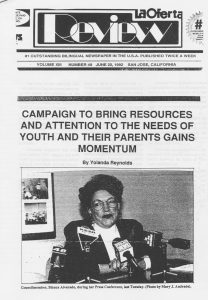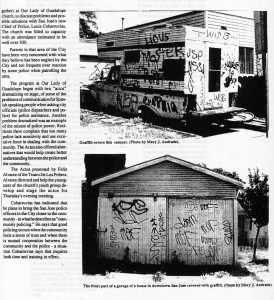June 20, 1992
By Yolanda Reynolds

San Jose leaders and City officials are directing increased attention to the needs and problems of the City’s youth. One approach was presented last Tuesday at an “Enhanced Graffiti Abatement Program.”
Alvarado said that though the City has had, since 1987, a program to eliminate graffiti and “tagging,” (spray painting walls with specific symbols) that has had some success, more attention is needed to deter the problem.
Alvarado explained that while some people view tagging and wall painting with spray cans as art, others see it as vandalism and the destruction of property.
According to Alvarado, at first the graffiti was concentrated downtown but is now found all over the City and seems to be gang related.
Attempts have been made to deter the young, often talented, youngsters that engage in tagging and spray painting on others property, and who then end up in the juvenile law enforcement system, Alvarado says that much of it occurs because the young are bored and have “few positive options.” She says that some of the graffiti is a result of pent up anger with much what is happening.
To help these young people, Alvarado says that the “root problems affecting many of the City’s youth must be addressed.”
Alvarado has proposed that parents of children who have been cited for graffiti-offense be required to attend anti-graffiti presentations with their children. Currently, the graffiti abatement educational program provides for presentations to be made to school children in grades 3-6.
Alvarado suggests a second part be added to the abatement program which would encourage voluntary participation of parents with their children in the clean-up of the graffiti – with the possibility of this becoming mandatory.
Another very important element in Alvarado’s plan is a recommendation of the establishment of a year-round employment program. Alvarado has requested that this program be developed by mid-August and operational by fall.
Alvarado is also requesting that a previously proposed graffiti “hotline” be installed, as well as requiring that the City appoint a member of the City’s Graffiti Program to the Gang Task Force.
Alvarado says that police report that most of the graffiti painting work occurs between the hours of mid-night and four a.m.
Youth, gangs, drugs, and myriad of other related issues brought hundreds of parents, many accompanied by their children, to several meetings in the south central and east Side of San Jose. Thursday evening.
One meeting was held by PACT (People Acting in Community Together) at Our Lady of Guadalupe church, to discuss problems and possible solutions with San Jose’s new Chief of Police, Louis Covarruvias. The church was filled to capacity with an attendance estimated to be well over 500.
Parents in that area of the City have been very concerned with what they believe has been neglect by the City and too frequent over reaction by some police when patrolling the area.

The program at Our Lady of Guadalupe began with two “actos” dramatizing on stage, of some of the problems of communication for Spanish speaking people when asking city officials (police dispatchers and police) for police assistance. Another problem dramatized was an example of the misuse of police power. Residents there complain that too many police lack sensitivity and use excessive force in dealing with the community. The Actos also offered alternatives that would help create better understanding between the police and the community.
The Actos presented by Felix Alvarez of the Teatro De Los Pobres.
Alvarez directed and helped the youngsters of the church’s youth group develop and stage the actos for Thursday’s evening meeting.
Covarruvias has indicated that he plans to bring the San Jose police officers in the City closer to the community – in what he describes as “community policing.” He says that good policing occurs when the community feels a sense of trust and when there is mutual cooperation between the community and the police – a situation Covarrubias says that requires both time and training to effect.
To the numerous community requests presented by the PACT leadership at Our Lady of Guadalupe, the promised: that he step up patrol in areas surrounding schools between the hours of 7:30 and 5:30 p.m.; step up the investigation of homes suspected of drug dealing; provide leadership in encouraging schools to develop better security on school campuses.
Covarruvias said that he would ask Councilwoman Alvarado’s assistance in getting a Jack-in-the-Box, located between McCreery and King Road. to hire security front 6 pm. To 6 a.m. Recently a man was killed in that location.
Covarruvias also detailed the steps that he was taking to eliminate police misconduct. He outlined the San Jose police program that does attempt to provide multicultural training for its officers but said that he would make sure that all new officers and others assigned to the neighborhood be exposed to an expanded program in cultural sensitivity, in particular Hispanic culture. He said that he plans to assign one of the new officers to the neighborhood community area and pay particular attention in having as many bilingual officers possible. Cobarruvias assured PACT leaders that he would continue to meet with them and in fact asked that he meet earlier than the August date suggested by PACT.
Covarrubias praised San Jose City Councilpersons Alvarado and Shirakawa for their leadership in the recently announced program to cleanup and rehabilitate the run down, blighted drug and vermin infested Poco Way Apartments nearby. PACT had some time been after the City’s help in correcting the problems at Poco Way.
At the same time, several miles away, at the Franklin-McKinley School District Officers, another important meeting was held. At that meeting, San Jose Mayor Susan Hammer made a key presentation in which she announced the City’s support for the development of a comprehensive program entitled. “San Jose Fighting Back? which will be designed to help in “reducing the demand for alcohol and drugs” in the community.
Mayor Hammer accepted the lead role when the Alum Rock Counseling Center sought her help in achieving the modifications to a plan they had developed to apply for an award from the Robert Wood Foundation of $3 million (to help with youth drug and alcohol abuse). The Center was asked to make some specific structural and content modifications and to then reapply. The Foundation felt that there had not been adequate community and inter-agency participation in planning the program.
Last year more than 700 organizations applied for this grant, fifteen were awarded nationwide. The Robert Wood is reported to be the “largest philanthropy devoted exclusively to health in the United States.”
This year Mayor Hammer appointed Dick de la Rosa to head the City’s Drug Task Force program for addressing the problems of substance abuse and gang participation among the San Jose’s youth.
De la Rosa says that, whether or not San Jose is selected for a grant this year, the City is committed to work on these concerns. He says that the City has already committed $2 million towards the objectives of this program and also to launch a $3 million fund raising program to add to that $2 million.
To this end, Hammer is reported to have enlisted former mayor Tom McEnery’s help in co-chairing a drive seeking corporate and individual donations of cash or “in kind” support for this important task.
The presence at the Franklin McKinley meeting of many City officials including City Manager Les White, Councilman David Pandori, Parks and Recreation Director Robert Overstreet, numerous law enforcement officers and staff. attested to the importance of this project. Many of the staff were present to help conduct the “breakout” (smaller) meetings designed to better ascertain the needs of the community. Once defined, these needs will, in turn, be shared with community service providers. There were many service provider officials at the meeting. To participate in the San Jose Fighting Back program service providers will have to demonstrate that their programs are suited to serve the needs identified by the community.”
The Franklin McKinley neighborhood area, like others in San Jose, is interesting because of the different languages spoken by its residents, the dominant languages other than English are Vietnamese, Cambodian, and Spanish.
To accommodate the different primary languages of the parents, the groups were divided into groups by the languages spoken, so that communication would flow more easily. The evening was filled with much discussion.
The project leaders sought the help of the parent participants in addressing a number of key questions, which will determine the scope and final plan of the project.
The questions they addressed dealt with; how and where do the parents go for help?, why they went there?, for what services?, how do they access those services?, and what other options of service would be helpful?, among others.
The first question on the list was whether, the parents felt that there was a drug and alcohol abuse problem.”
The area in San Jose that will be included in the first stage of this program will encompass a 17.76 square mile area which extends from 10th and Julian street down to Keys, then joins further south down Senter until Hellyer goes eastward along Capitol onto Capitol Ave. and then north to McKee.
According to Michael Canul of the Mayor’s office, approximately 170,000 people live in this area. He said that this area of the City was chosen for the project area because of the high incidence of crimes in comparison to the size of its population.
According to City statistics, 30.7% of all crimes committed in San Jose were “experienced” by this community while its population makes up only 13.2% of the City’s total population.
The project participants will ultimately include religious and community groups, school and City officials and local corporations. The City Council Districts that are located in this area are; a portion of District 3 (David Pandori), District 5 (Blanca Alvarado) and District 7 (George Shirakawa). After voter rejection of the Stadium, Mayor Hammer recently announced that neighborhoods and youth would, for her administration, be a first priority. For many in the City, this is a direction that they have long awaited. PACT has had a traveling program, asking for a “Fair Share for Youth.” Many in the City find that his emphasis is particularly important, since schools are making drastic cuts in their programs, even those programs that have traditionally been offered during the normal school day. In addition, many families have one or more members who are unemployed, and there are many young children with idle, unsupervised time, who become targets of aggressive solicitation by people who see them as a fresh market for alcohol and drug consumption.
For more information on PACT at Our Lady of Guadalupe telephone 258-7057. Mayor Hammer and other city officials may be contacted by telephoning 277-4000. © La Oferta Newspaper.
